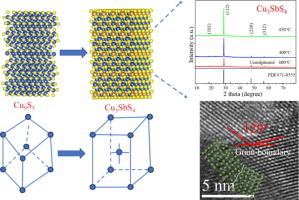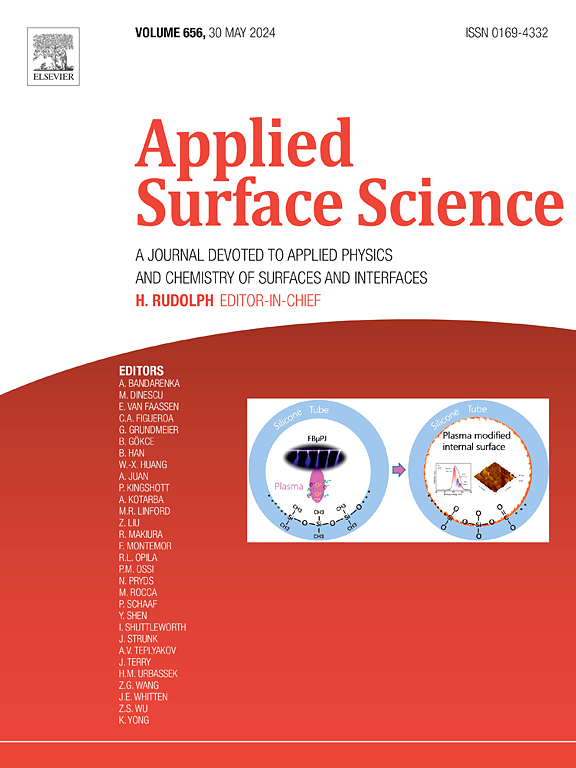Synthesis of thermally stable Cu3SbS4 thin films with high charge density: Doping of Sb atoms in hexagonal Cu9S5 close-packed planes
IF 6.3
2区 材料科学
Q2 CHEMISTRY, PHYSICAL
引用次数: 0
Abstract
Cu3SbS4 is commonly used as a hole transport layer in heterojunction devices due to its high valence vacancy, which provides a large number of carriers. The preparation of Cu3SbS4 by large-scale dry chemistry is often accompanied by the generation of other copper antimony sulfide ternary phases during the heating process. By exploiting phase transitions in the crystal structure, the synthesis of nanophases can be controlled to improve the properties of the material. Different choices of the main material structure can trigger the evolution of the internal structure of the product material. In the experiment, the fusion of antimony atoms with host Cu9S5 crystals will preferentially produce thermally stable Cu3SbS4. The stepwise synthesis of Cu3SbS4 films from Sb-Cu9S5 stacked films was discovered. The influence of reaction temperatures on crystal structure, surface morphology, chemical composition of the films was investigated, and the optical and electrical properties of the films were analyzed during the alloying process. The pure Cu3SbS4 was obtained by heating and melting Cu9S5 and Sb in a sulphur vapor environment. The Cu3SbS4 films obtained at 450 °C have a forbidden bandwidth of 0.89 eV and a charge density of 1.39 × 1020 cm−3. These findings provide an explanation for the phase transition and morphological changes during the synthesis of copper antimony sulphide and offer a new thinking strategy for the alloying of synthetic ternary copper-based sulphides.


高电荷密度热稳定Cu3SbS4薄膜的合成:在六方Cu9S5密排平面上掺杂Sb原子
由于Cu3SbS4具有较高的价空位,提供了大量的载流子,因此常被用作异质结器件中的空穴传输层。大规模干化学法制备Cu3SbS4时,在加热过程中往往伴随着其他硫化铜锑三元相的生成。利用晶体结构中的相变,可以控制纳米相的合成,从而改善材料的性能。主体材料结构的不同选择会引发产品材料内部结构的演变。在实验中,锑原子与宿主Cu9S5晶体的融合将优先产生热稳定的Cu3SbS4。发现了由Sb-Cu9S5叠层膜逐步合成Cu3SbS4膜的方法。研究了反应温度对薄膜的晶体结构、表面形貌和化学成分的影响,并分析了合金化过程中薄膜的光学和电学性能。通过在硫蒸气环境中加热和熔化Cu9S5和Sb,得到了纯净的Cu3SbS4。在450 °C下得到的Cu3SbS4薄膜禁带带宽为0.89 eV,电荷密度为1.39 × 1020 cm−3。这些发现为铜锑硫化物合成过程中的相变和形态变化提供了解释,并为合成三元铜基硫化物的合金化提供了新的思路。
本文章由计算机程序翻译,如有差异,请以英文原文为准。
求助全文
约1分钟内获得全文
求助全文
来源期刊

Applied Surface Science
工程技术-材料科学:膜
CiteScore
12.50
自引率
7.50%
发文量
3393
审稿时长
67 days
期刊介绍:
Applied Surface Science covers topics contributing to a better understanding of surfaces, interfaces, nanostructures and their applications. The journal is concerned with scientific research on the atomic and molecular level of material properties determined with specific surface analytical techniques and/or computational methods, as well as the processing of such structures.
 求助内容:
求助内容: 应助结果提醒方式:
应助结果提醒方式:


